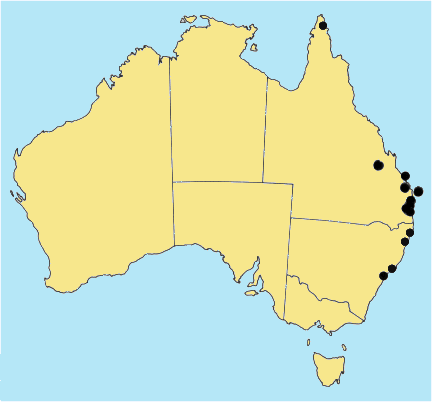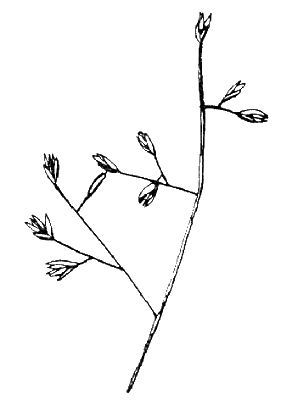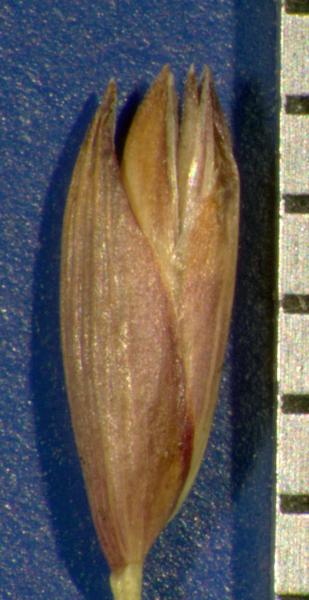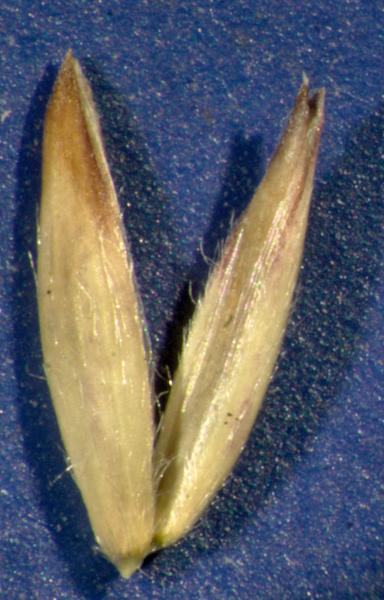Eriachne glabrata (Maiden) Hartley. J.
Linn. Soc., Bot. 52: 347 (1942).
Classification. (GPWG 2001) : Subfamily
Micrairoideae. Eriachneae.
Basionym and/or
Replacement Name: Eriachne obtusa
var. glabrata Maiden, Agric. Gaz. N.S.W. 19:836 (1908).
Type of Basionym or
Protologue Information: Australia, Port Jackson: Forsyth (NSW holo,
B, BM, K).
Key references
(books and floras): [2002] D.Sharp & B.K.Simon, AusGrass, Grasses of
Australia, [2008] S.W.L.Jacobs, R.D.B.Walley & D.J.B.Wheeler, Grasses
of New South Wales (260).
Illustrations:
[1984] N.T.Burbidge. rev. S.W.L.Jacobs, Australian Grasses (137), [2008] S.W.L.Jacobs, R.D.B.Whalley
& D.J.B.Wheeler, Grasses of New South Wales, 4th edn (260).
Habit.
Perennial. Culms 7–40 cm tall, 2–5 -noded. Mid-culm internodes woolly. Mid-culm
nodes glabrous or pubescent. Lateral branches simple. Ligule a fringe of hairs.
Leaf-blades erect, involute, 2–4(–8) cm long, 1–2 mm wide. Leaf-blade surface
scaberulous, glabrous or indumented.
Inflorescence.
Inflorescence compound, a panicle. Panicle ovate, 1–4(–5.5) cm long, 0.5–2(–30)
cm wide.
Spikelets.
Spikelets pedicelled. Fertile spikelets 2-flowered, both fertile, comprising 2
fertile floret(s), without rachilla extension, cuneate, laterally compressed,
3–4 mm long.
Glumes.
Glumes similar, thinner than fertile lemma. Lower glume ovate, membranous,
without keels, 7–9 -nerved. Lower glume surface glabrous. Upper glume ovate,
2.5–3.5 mm long, membranous, without keels, 5–7 -nerved. Upper glume surface
smooth, glabrous.
Florets.
Fertile lemma 2.5–6 mm long, without keel, 5–7 -nerved. Lemma surface indumented. Lemma apex muticous.
Palea 2 -nerved. Palea apex entire, muticous. Grain 1.5–2 mm long.
Continental
Distribution: Australasia.
Australian
Distribution: Queensland, New South Wales.
Queensland:
Leichhardt, Moreton, Wide Bay, Cook, Port Curtis. New South Wales: North
Coast, Central Coast.
Notes.
A distinctive species characterised by the relatively short basally compact
habit, thin rigid blades, simple few-noded culms, sparse simple or racemose
panicles, florets longer than glumes, obliquely attached unequal glumes,
awnless sparsely appressed-pubescent lemma and palea, and cuneate flattened
caryopsis. It has similarities with E. insularis.
Endemic.
N.S.W. (Central Coast) and coastal southern Qld; recorded by Wheeler et al.
(1990) also from the N Coast of N.S.W., but the type from Port Jackson is the
only specimen from N.S.W. seen. Low-lying sandplains in association with
"wallum" scrub, low heath and open eucalypt forest, and sometimes on
disturbed ground. Flowers and fruits Dec.-Jan. (summer), Apr. (mid-autumn), and
July (mid-winter).






